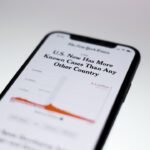In the digital age, communication has become an integral part of our daily lives, facilitated by smartphones that allow us to connect with others instantly. However, this ease of communication also brings challenges, particularly when it comes to unwanted interactions. Both Android and iPhone users have the ability to block contacts, a feature designed to provide users with control over their communication experiences.
Blocking can be a necessary tool for maintaining personal boundaries, whether it’s due to harassment, spam, or simply a desire to disengage from certain individuals. Understanding how blocking works on these platforms is essential for users who want to navigate their social interactions effectively. Blocking on Android and iPhone operates under similar principles but varies in execution and features.
When a user blocks someone, they typically prevent that person from calling, texting, or reaching them through various messaging apps. This action can be taken for numerous reasons, including protecting one’s mental health or avoiding unwanted conversations. The implications of blocking extend beyond mere communication; they can affect relationships and social dynamics, making it crucial for users to understand the nuances of this feature on their respective devices.
Key Takeaways
- Blocking on Android and iPhone is a common feature that allows users to restrict communication from specific contacts.
- Android and iPhone have different blocking features, with iPhone offering more options such as blocking texts, calls, and FaceTime.
- You can check for blocked calls and messages by observing the lack of notifications and the inability to make contact with the person.
- Social media can be used to determine if you’ve been blocked by checking for the person’s profile and activity.
- Trying to add the Android user on messaging apps can help determine if you’ve been blocked, as the request may not go through.
Understanding the Differences in Blocking Features
While both Android and iPhone offer blocking features, the specifics can differ significantly between the two operating systems. On iPhones, blocking a contact is straightforward; users can do this directly from the Phone app or through the Messages app. Once a contact is blocked, any calls or messages from that number are automatically silenced and sent to a blocked folder, ensuring that the user remains unaware of any attempts at communication.
Additionally, iPhone users can block contacts on various apps like FaceTime and WhatsApp, providing a comprehensive approach to managing unwanted interactions. In contrast, Android devices present a more fragmented experience due to the variety of manufacturers and custom user interfaces. While most Android phones allow users to block contacts through the Phone app or messaging settings, the process may vary slightly depending on the device model and operating system version.
Some Android devices may also offer advanced features such as call screening or spam detection, which can further enhance the blocking experience. Understanding these differences is crucial for users who may switch between platforms or who are trying to assist friends and family in managing their contact lists.
Checking for Blocked Calls and Messages

Determining whether you have been blocked by someone can be a perplexing situation. Both Android and iPhone users have methods to check for blocked calls and messages, although these methods may not always yield definitive answers. For iPhone users, if you suspect that you have been blocked, one of the simplest ways to check is by attempting to call the person.
If the call goes directly to voicemail without ringing, it could indicate that you have been blocked. However, this could also happen if the person’s phone is turned off or they are in an area with poor reception. Android users can employ similar tactics.
When calling a suspected blocked contact, if the call does not ring and goes straight to voicemail, it may suggest that you have been blocked. However, like with iPhones, this is not a foolproof method. Additionally, checking for missed messages can provide clues; if your texts are not being delivered (often indicated by a lack of “delivered” notifications), it may suggest that you have been blocked.
However, it’s essential to consider that network issues or the recipient’s phone settings could also be at play.
Using Social Media to Determine if You’ve Been Blocked
| Metrics | Results |
|---|---|
| Number of social media platforms checked | 3 |
| Number of accounts searched | 10 |
| Number of accounts found to be blocked | 4 |
| Percentage of accounts blocked | 40% |
Social media platforms often serve as an extension of our communication methods, and they can provide additional insights into whether someone has blocked you. On platforms like Facebook or Instagram, if you can no longer find a person’s profile or see their posts, it may indicate that you have been blocked. For instance, if you previously had access to their content and suddenly cannot find them in your friend list or search results, this could be a sign of being blocked.
However, it’s important to approach this with caution. Users may deactivate their accounts or change privacy settings without necessarily blocking anyone. On Twitter, if you attempt to view a user’s profile and receive a message stating that you are blocked from viewing their tweets, it is a clear indication of being blocked.
Each platform has its own set of rules regarding privacy and blocking, so understanding these nuances can help clarify your situation without jumping to conclusions.
Trying to Add the Android User on Messaging Apps
Another method to ascertain whether you have been blocked is by attempting to add the person on messaging apps such as WhatsApp or Telegram. If you are blocked on these platforms, you will typically encounter specific indicators that suggest this status. For instance, on WhatsApp, if you try to send a message and it only shows one check mark (indicating sent but not delivered), this could imply that you have been blocked by the recipient.
Moreover, if you notice that you can no longer see the person’s profile picture or status updates on WhatsApp, this further supports the possibility of being blocked. On Telegram, similar signs exist; if you cannot see a user’s last seen timestamp or profile picture after previously having access to them, it may indicate that they have restricted your access. These messaging apps often provide clear visual cues that can help clarify your standing with another user.
Observing Changes in Group Chats and Messaging Apps

Group chats can serve as another avenue for determining whether someone has blocked you. In many messaging applications like WhatsApp or Facebook Messenger, if you are removed from a group chat where both you and the suspected blocker were previously members, it could suggest that they have taken steps to limit your interaction. However, it’s essential to note that being removed from a group chat does not definitively mean you have been blocked; it could simply be a decision made by the group admin or another member.
Additionally, if you notice that messages sent in group chats are not visible to one particular user who was previously active in those discussions, this could indicate that they have either muted notifications or blocked someone within the group context. Observing these dynamics can provide insights into your relationship with the individual in question while also highlighting how group interactions can complicate personal communication.
Paying Attention to Read Receipts and Delivery Notifications
Read receipts and delivery notifications are features available on many messaging platforms that can provide valuable information about your communication status with others. For instance, on iMessage (iPhone), if you send a message and do not see the “read” indicator beneath your message after some time—especially if this was previously visible—it may suggest that you have been blocked. Similarly, on WhatsApp, if your messages consistently show only one check mark instead of two (indicating delivery), this could imply that your messages are not reaching the recipient.
However, it’s important to remember that some users may disable read receipts or delivery notifications for privacy reasons. This means that while these indicators can provide clues about your status with someone else, they are not definitive proof of being blocked. Users should consider other factors alongside these notifications before concluding their communication status with another individual.
Testing the Blocking Status with a Mutual Friend
If uncertainty persists regarding whether you have been blocked by someone, enlisting the help of a mutual friend can be an effective strategy. By asking a mutual acquaintance to reach out to the suspected blocker on your behalf, you can gain insights into their current communication preferences without directly confronting them. This approach allows for a more discreet investigation into your relationship dynamics while minimizing potential awkwardness.
However, this method should be approached with caution and sensitivity. It is essential to ensure that your mutual friend is comfortable with this request and understands the potential implications of their involvement. Additionally, consider how this action might affect your relationship with both parties involved; transparency and respect should guide any actions taken in this context.
Using Third-Party Apps to Detect Blocking
In an age where technology offers numerous solutions for various problems, several third-party applications claim to help users determine whether they have been blocked by someone on messaging platforms. These apps often analyze call logs and message delivery statuses to provide insights into your communication history with specific contacts. However, users should exercise caution when using such applications due to privacy concerns and potential security risks.
Many third-party apps require access to personal data or permissions that could compromise user privacy. Additionally, there is no guarantee that these apps will provide accurate information regarding blocking statuses; they may rely on algorithms that do not account for all variables involved in communication dynamics. Therefore, while these tools may seem appealing for resolving uncertainty about blocking status, users should prioritize their privacy and consider alternative methods before relying solely on third-party solutions.
Considering the Possibility of Technical Issues
Before jumping to conclusions about being blocked by someone, it is crucial to consider potential technical issues that could affect communication between devices. Network problems can lead to missed calls or undelivered messages without any indication of blocking taking place. For instance, if either party experiences connectivity issues due to poor signal strength or network outages, it may appear as though messages are not being received when in reality there is an underlying technical problem.
Additionally, software updates or glitches within messaging applications can also lead to unexpected behavior in communication features. Users should remain aware of these possibilities before assuming they have been blocked; troubleshooting common technical issues may resolve misunderstandings without escalating tensions between individuals.
Handling the Situation with Sensitivity and Respect
Navigating situations involving potential blocking requires sensitivity and respect for all parties involved. If you suspect that someone has blocked you or if you find yourself in a position where you need to block someone else, approaching the matter thoughtfully is essential for maintaining healthy relationships. Open communication is often key; if appropriate, consider discussing any concerns directly with the individual rather than making assumptions based solely on circumstantial evidence.
If blocking becomes necessary due to harassment or negative interactions, it is vital to prioritize personal well-being while also considering how such actions may impact others emotionally. Ultimately, fostering understanding and compassion during these situations can help mitigate misunderstandings and promote healthier communication practices moving forward.
FAQs
What are the signs that an Android user has blocked you on iPhone?
Some signs that an Android user has blocked you on iPhone include not being able to see their online status, not receiving their messages or calls, and not being able to view their profile picture or last seen status.
Can I still send messages to an Android user who has blocked me on iPhone?
If an Android user has blocked you on iPhone, your messages will not be delivered to them. You will not receive any notification that your messages were not delivered.
Is there a way to confirm if an Android user has blocked me on iPhone?
Unfortunately, there is no direct way to confirm if an Android user has blocked you on iPhone. However, the signs mentioned earlier can help you determine if you have been blocked.
Can I unblock myself from an Android user’s iPhone?
No, you cannot unblock yourself from an Android user’s iPhone. The decision to block or unblock a contact lies solely with the Android user.
What should I do if I suspect that an Android user has blocked me on iPhone?
If you suspect that an Android user has blocked you on iPhone, you can try reaching out to them through other means, such as a different messaging platform or in person, to confirm if you have been blocked.










